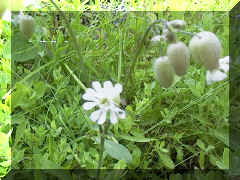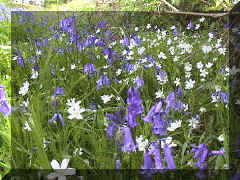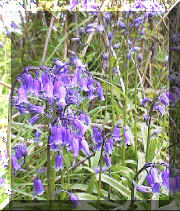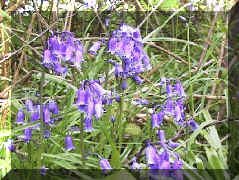|
Design
By Nature - wildflowers.ie - Irish Wildflowers
|
|
Species Datapage No
3
|
|
You may
click on most photographs to enlarge. *Denotes a Naturalised
species
|
|
Scroll down to find a species
|
|
Return
to Species List Index Page
|
|
|
| Species Common Name: Bladder
Campion
|
| Species Botanical Name: Silene
vulgaris
|
|
|
|
 A perennial herb found in a wide range of fertile disturbed habitats including spoil
heaps, waste ground, steep banks, building rubble, Dry ground and sandy
places.
A perennial herb found in a wide range of fertile disturbed habitats including spoil
heaps, waste ground, steep banks, building rubble, Dry ground and sandy
places.
|
| Occasionally in various others such as paths, stream sides, etc. Intolerant of shading and absent from wetlands.
Competes well with most grasses.
|
Seed
germinability can be rapid and growth slow but it sends down roots so by
year three Bladder Campion is a large self seeding perennial
|
Management: Moderate persistence in unmanaged grassland
Moderate tolerance of cutting but will compete on steep banks with no
cutting.
Management options: Keep fertility poor,
| Tolerance
of cutting: medium, will re-grow and
flower if cut in summer. |
| Cutting
time: Summer / autumn |
|
Edible
/ Medicinal: Dried flower/seed heads for decorations, Edible green
leaves but chewy.
|
|
|
Life Cycle (Form): Long-lived
perennial in the right situation, Short lived elsewhere
Flower Height: Flowers to
90cm
Foliage Height: Leaves to
25cm
Flower Colour:
White
Flowering period:
June-August
Time to Flower: 1-2-3 years
Soil Type:
Rubble gravel sand loam clay limestone
pH range
6-7.5 7.5-9
Moisture: Dry, normal
Aspect: Warm
and sunny
Winter
green: No
Wildlife
value Good especially for Butterflies.
|
|
See also Sea Campion,
species open pollinated and Cross breeds with Red Campion
|
|
Return
to Species List Index Page
|
|
|
| Species Common Name: Bluebell
|
|
Species Botanical Name: Hyacinthoides
non-scriptus see
also BSBI
|
|
|
 Bluebell and white Hedge Stichwort
Bluebell and white Hedge Stichwort |
| Bluebells require little
introduction, But they are grown from seed to produce a bulb and then
flower. In the early years the young bulb looks like a chive then it develops
true leaves and flowers. Bluebells contain poison or very strong alkaloids
and care should be taken when handling.
A hedgerow and woodland species will grow in certain acid grasslands
such as are found in the Wicklow Hills
Will grow well amounts bracken
fern with wild violets
|
|

Management: Persistence in woodland and certain managed grassland.
Moderate tolerance of cutting but will compete well on steep banks with no
cutting.
Management options: Keep humus levels high, shelter the woodland floor,
|
| Tolerance
of cutting: None, |
| Cutting
time: |
|
Edible
/ Medicinal:
Poisonous species.
|

|
|
Life Cycle (Form): Perennial
Bulb
Flower Height:
30-50cm
Foliage Height: 10cm
-15cm
Flower Colour: Blue,
(white, lilac and Pink in Cork area)
Flowering period: March
to May
Time to Flower: 3
Years
Soil Type:
All except bog peat
pH Type: 5
to Neutral to 7 provided a leaf litter builds up, such as in woodland or
under bracken fern.
Moisture:
Dry to wet
Aspect:
Shade and sunny banks where the roots are cool,
Wildlife Value: Where found
Growing the public tend to want to protect such sites.
|
|
|
|
|
|
Return
to Species List Index Page
|
|
|
| Species Common Name: Bog Asphodel
|
|
Species Botanical Name: Narthecium ossifragum
|
|
|
|
Bog
loving, common species that grows from seed on wet peaty soils,
|
|
No Photograph available.
|
Management: Moderate persistence in peaty grassland.
Keep fertility poor,
| Tolerance
of cutting: None, except end of
season management |
| Cutting
time: None |
|
Edible
/ Medicinal: Very Medicinal. Do not consume unless advised. Probably contain
poisons
|
|
|
Life Cycle (Form):
Short lived rootstock seems to die after flowering.
Flower Height:10cm-
20cm
Foliage Height: 2cm
Flower Colour: yellow
to orange
Flowering period: July,
August and into September
Time to Flower: 2
years
Soil Type:
peat
pH Type:
acid
Moisture:
Moist to wet, if on dry peat it will grow if seedlings are not allowed
to dry out.
Aspect: A
wonderful upland species and in open sunny wet situations on bogs
throughout Ireland, very common.
|
|
|
 A perennial herb found in a wide range of fertile disturbed habitats including spoil
heaps, waste ground, steep banks, building rubble, Dry ground and sandy
places.
A perennial herb found in a wide range of fertile disturbed habitats including spoil
heaps, waste ground, steep banks, building rubble, Dry ground and sandy
places.

